A literature review of research in Web browsing, followed by a collection of ideas and experiments with an interactive prototype. Adapted from a series of blog posts in my Igalia blog between 2011 and 2013.
First readings on web browsing
This project begins with a review some of the many available works on the field of Web browsers for the desktop, with the goal of improving the design of the Epiphany browser and taking advantage of the fact that Igalia is one of the main maintainers of WebKitGTK+. The first task, of course, is to correctly understand the problem: in a field as big and complex as this, this means a lot of reading and synthesising. In this first section, I will explore two particular aspects: revisitation and tabbed browsing. In the future I will expand on this and begin to share some design ideas.
Revisitation
Revisitation means to access web sites that have been already seen previously. Although there are discrepancies on how to measure it, for the sake of design we can say that we have already seen roughly half of the pages that we visit. The article by Obendorf et al. mentions three kinds of revisitation:
- short-term revisits (within the hour): these are the most common, often performed by following links, or using the Back button;
- mid-term revisits (within the day): the most usual way is to use bookmarks or write the URL (often helped by autocomplete);
- long-term revisits: this is related to the rediscovery of information that has already been seen; people re-access these pages mainly through links because they need to re-search (enter the same search terms) and/or re-trace (follow the same steps); history and bookmarks are also employed to some extent, but the current interfaces might not be easy or convenient to use.
Previously-unseen pages are usually visited by directly entering a URL or by following links from search pages (e.g. Google) or other information hubs (e.g. reddit, news sites).
A wider research was carried out by Adar, Teevan and Dumais. Their findings are consistent to those above, as they found that Web page revisitations could be clustered in the same three groups plus another one, which they called hybrid and which contained sites that were popular but infrequently used. They went further in trying to analyse the kind of web sites that typically fell on each group. The fast revisitation pattern often corresponded to “hub&spoke” behaviour, where users move back and forth between a set of promising results and each individual item. The mid-term one tended to refer to pages that act as starting points where the user can carry out a task (e.g. communication, banking) or access new information (e.g. news, forums). The infrequently-accessed group comprised pages that provide specialised search (e.g. travel) or related to weekend activities; as in the previous paper, the researchers also note that external search engines are often used for revisitation. There was a fourth, hybrid group of pages that caused “hub&spoke” movement but that were infrequently accessed, such as craigslist, eBay, shopping, games, etc.
With these results, the researches mention a number of implications for design. The most interesting for me is that “there may be value in providing awareness of, and grouping by, a broader range of revisitation patterns. For example, users may want to quickly sort previously visited pages into groups corresponding to a working stack (recently accessed fast pages), a frequent stack (medium and hybrid pages), and a searchable stack (slow pages).”
Research on tabs
During the last years the usage of tabs has made the Back button less prevalent. For instance, a common behaviour is to perform a search and then open different results in their own tabs, attempting to find the desired information through exploration of the candidates without losing track of the result set for further refinement. This often causes problems because the Back button does not work as expected (local history only applies to the current tab) and it might be complicated to find the originating document in the case of large tab trees. Problems with the Back button also arise when entering information through web forms and when using web applications.
A study of tab usage on Firefox showed that tabs are mostly used for immediate revisitation and task-switching. They serve as reminders or short-term bookmarks, they allow users to open links in the background and are a convenient way to keep frequently-accessed pages open. Visually, they are cleaner, less cluttered and easier to access that separate browser windows.
Many participants used tabs for revisitation more often than the back button, up to the point where, for frequent tabs users, tab switching was the second most frequent thing they did in the browser (after following links). The reasons reported were that tabs were more efficient, more convenient and more predictable (you can see the target right away). Another factor that helps to ease multitasking is that tabs leave the page in the same state, which is not always true with the back button.
The study found marked differences between regular and power tab users. The median number of open tabs was reported at around 6, but the maximum number of open tabs at one point in time could get much higher than that, past 20 and beyond for some users. As the participants were using regular Firefox, it could be that for some a limiting factor to the number of open tabs might simply be lack of space.
A bit of personal experience
As a user of the Tree-style Tabs extension for Firefox, I often find myself creating long trees of tabs where the tree itself marks a trail that is coherent and useful. I do not use the Back button often, and I think that the reason might be that opening a new branch in the tree somehow makes that part of the trail useful, clear and important, whereas pages that can only be accessed by going back soon fade out of memory. For a given task, it might well be that there is value in having a clear structure of related sites: the combination of tree-style tabs and the Back button helps create and navigate this structure.
Opening a link in a new tab actually marks the previous one as interesting and worth keeping around for a while, whereas closing a tab or following a link signals that the previous page was not that interesting after all (and it will fade from memory soon). This way of looking for information is probably related to orienteering, an information seeking strategy in which users take small steps towards their target using partial information and contextual knowledge as a guide. Making said set of steps visible and semi-permanent also acts as a very convenient reminder: my tab structure is kept between sessions, which makes it very easy to resume work or reading (for instance, there is a small subtree hanging from my RSS reader tab with articles that I will read later, and another one hanging from Bugzilla with bugs that I am working on).
Longer-term revisits
Regarding mid- and long-term revisits, I propose to contemplate three kinds of sites: web applications, information hubs and the personal archive. Web applications are self-contained and focused mainly on one task; their goal is in most cases to replace local applications for e.g. email, calendar, project planning, music, etc.
It might make sense to separate frequently visited websites that periodically provide new content from concrete and interesting information items; you can think about as the difference between reading the newspaper everyday and cutting out a news item that mentions your amateur football team. Information hubs are pages that are visited often because they lead to the discovery of new information, either on the same site (e.g. guardian.co.uk) or on others (e.g. reddit.com). On the other hand, the personal archive is a collection of information items that are relevant for the user because of the information that they already contain. There are many motivations behind the construction of personal archives: not just simply storing things for later retrieval, but also creating a legacy, making it easier to share resources, reducing fear of loss, self-expression and self-identity.
References
“Web Page Revisitation Revisited: Implications of a Long-term Click-stream Study of Browser Usage”, Obendorf et al., CHI 2007 Proceedings [PDF]
“A Study of Tabbed Browsing Among Mozilla Firefox Users”, Dubroy et al., CHI 2010 [PDF] [Presentation]
“Large Scale Analysis of Web Revisitation Patterns”, Adar et al., CHI 2008 [PDF]
“To have and to hold: exploring the personal archive”, Kaye et al., CHI 2006 [PDF]
“The Perfect Search Engine Is Not Enough:A Study of Orienteering Behavior in Directed Search”, Teevan et al., CHI 2004 [PDF]
Alex Faabor’s blog
Mozilla’s blog of metrics
Design proposals for Epiphany: EpiphanyRedux, hbon’s mockups
First ideas for a better GNOME browser
Following up on the literature review, I want to share a few ideas that could improve the use of the Web from GNOME, providing a tighter integration between browser and desktop. Many of these come from other people and I am trying to combine them into one coherent package.
The first goal would be to offer better support for common Web browsing patterns, revisitation and exploration. Specifically, this means supporting web applications, a more convenient and agile presentation for favourites, better history and bookmarks management, better tab management within the browser window for pages that are related to the same tasks, and better tab management from the Shell to help the user align the different sets of tabs with his current activities and interests.
The second goal would be to do so in a way that is not cumbersome and complex, but light and consistent.
Web apps
Most of the next million apps written will be web applications. The browser should acknowledge this, allowing the user to turn a Web site into an application that can be accessed like any other.

Launcher for a GMail app.
Revisitation: Home and History
As noted in my previous post, there are different kinds of Web revisitation; one of them comprises sites that we visit often because they lead to new information, which is not exactly the same as storing a linking to a page because of the information that it contains at the moment of reading (e.g. an article). In a manner similar to what Firefox does, I propose to have a Home tab as the starting point for browsing. This tab could include a search field, links to recent pages and groups of pages, favourites and Reading List. Being able to define a page as “favourite” and “pin” it to the Home page would ease mid- and long-term revisitation, which makes up for a large percentage of our activity in the Web.
The Home tab would be a way to get to new content, but what about returning to sites that were visited some time ago? Next to the Home tab, we could place a History&Bookmarks tab that offered a rich search interface to retrieve pages that have already been seen.
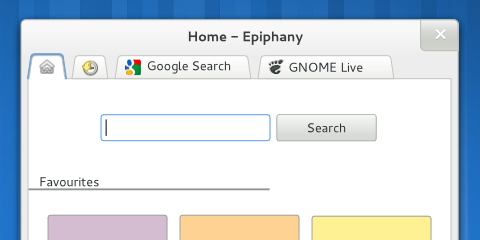
Tabs on top, with Home and History on the top left.
Fine-grain tab management
Modern browsers are placing their tabs on top with good reason. The main advantage is that this helps establish a visual hierarchy inside the browser window that reinforces the proper mental model, so that controls that operate on the same scope are grouped together. To decide which controls should be given priority in the interface, we could use usage data from Firefox as a guide, always keeping in mind that we cannot assume that everybody will know how to use all the available shortcuts (e.g. a similar study found that over 80% of users never used Ctrl+F to search). Browser-level functionality (New Window, Preferences, Quit…) could be moved to the application menu.
Tabs provide a number of benefits that make them a convenient way to organise your Web browsing. However, one of their problems is that as their number grows, it can become difficult to go back to a certain tab; a way to improve this situation could be to show a thumbnail of the tab’s content on mouse-over, allowing for a quick scan of open tabs without having to open them one by one.
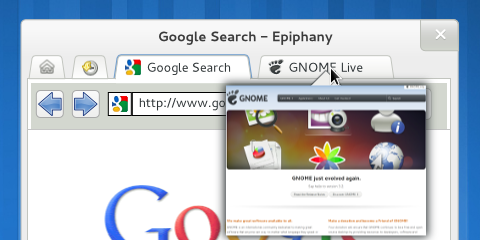
Tab thumbnail on mouse-over.
There is a difference between following a link and opening it in a new tab. In the first case, the original page is still visible and readily accessible; in the second, it has disappeared from the UI and has to be kept in the user’s memory, to be accessed again via the Back button. These two different actions can allow the user to create a curated version of their trail through the Web, one that does not contain all the pages that they have visited but just those that have been deemed important. These tab trees are an important feature but tab-focused interfaces (e.g. tree-style tabs, other ideas) might be far too complex. A compromise could be to include a visual hint at the existence of different tab groups, but without making it the main point of the interface.

Without text, can you tell which of these tabs are related?
Coarse-grain tab management
Tabs are a good way of structuring your browsing when their number is low enough (research shows that an usual number of open tabs is around 6). When their number grows, you can have trouble because there are simply too many unrelated tabs in one window. So we have a problem with the organisation of a lot of content that is related to different activities: well, the GNOME Shell is a solution for that. I propose to allow high-level management of Web tabs directly from the Shell Overview (not too different from Panorama with a bit of this), providing an overview of the open tabs and supporting their movement between different browser windows and workspaces.
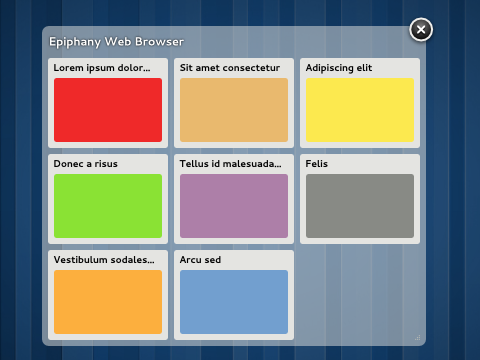
Epiphany window in the Shell overview, displaying the open tabs.
Interactive prototype
I wrote a small functional prototype to explore some of the design ideas for the evolution of the GNOME Web browser (maintained by Igalia). I thought that it would be a good idea to show these experiments to a wider public.
The basic idea by the GNOME designers is that, instead of tabs, open pages would be placed in an overview: you would click on a thumbnail there to return to a certain web page, and clicking again on “Pages” would take you back to the overview. A possible evolution of this would be to integrate bookmarks and reading lists in that overview.
This first video shows the interaction as described in the current design: in the overview, open pages are shown in a horizontal list, which gets reordered so that the leftmost element in the list corresponds to the last open tab. Note how the thumbnail is updated whenever we go back to “Pages”, and how the list scrolls to the left to show the most recently opened sites.
I also implemented an alternative UI where the open pages are arranged in a static 2D grid. Here it is:
This little application was written in a bit over 200 lines of QML. The code is available here:
The project folder includes compiled binaries that should work on, at least, 64-bit Debian and Ubuntu. Just uncompress it and run
cd Ephy ; ./Ephy
Note that if you want to build it yourself, you will need the qt4, qt-webkit and qmlviewer development libraries for your distribution; then, you can just run
make distclean ; qmake && make
Refined prototype
The problem that we are looking into is how to manage open pages in your Web browser. This is commonly done with tabs, but these have some problems: they display very little information, are hard to use in touch screens, and scale badly.
To illustrate this last point, here is how 15 open pages would look in Epiphany right now:

Hardly ideal.
This work looks into alternative in-app navigation among open pages that would (hopefully!) improve Web browsing. I started by prototyping the current proposal in the GNOME wiki and have continued from there. From the previous iteration, it seemed that a grid view might be a good solution for choosing among open pages:
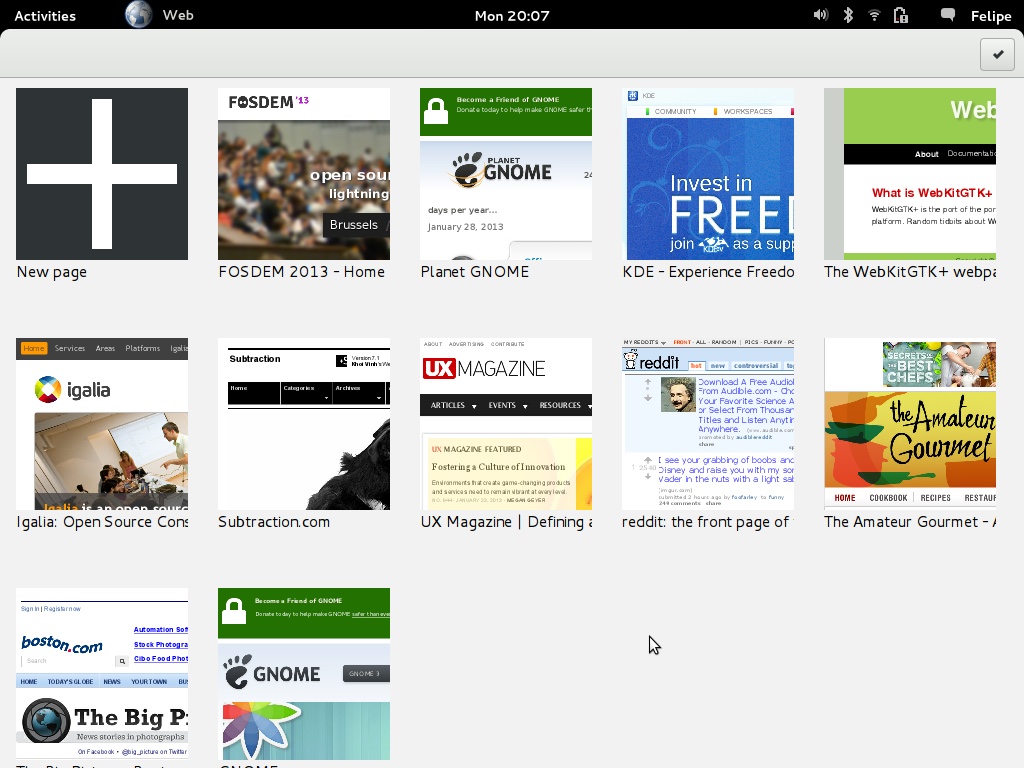
Grid with open pages.
I have extended that idea with a “New Page” view that would allow the user to review and search among his bookmarks, recently visited pages, reading list, etc. For now, this view just offers a fixed list of sites to illustrate how navigation would work, but it wouldn’t be hard to extend it to try more complex behaviour:
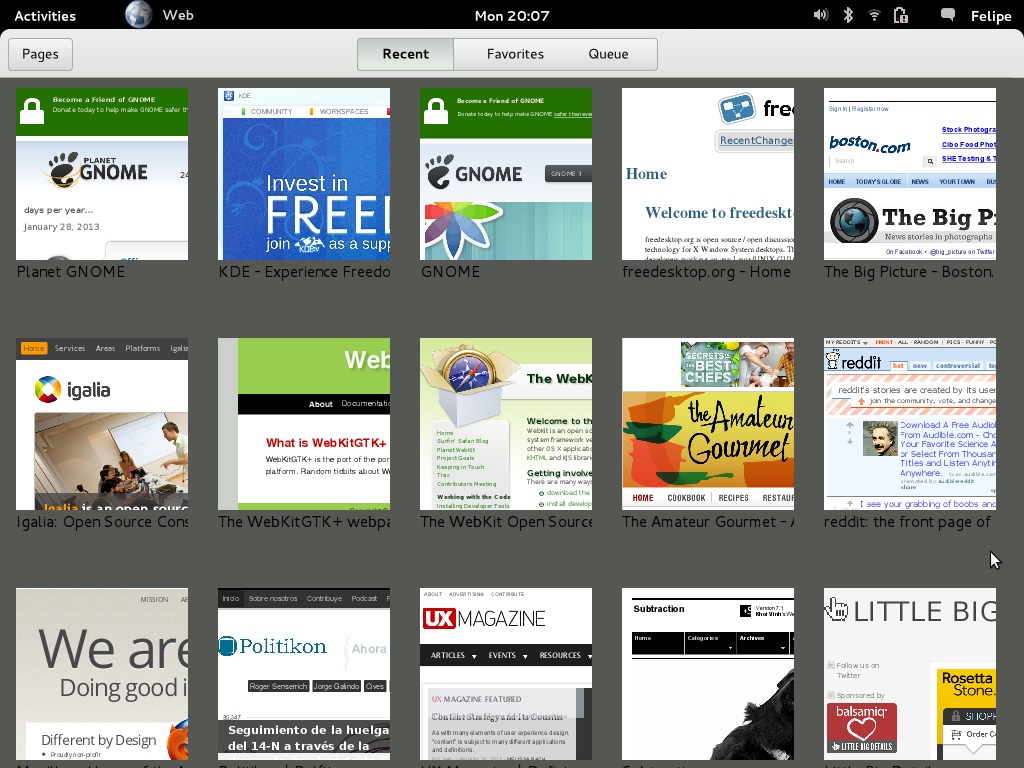
New Page view.
You can get the code here.
And this is how it looks in action:
Part of the reason for working on this was to offer some ideas to the GNOME community who are working on Epiphany and WebKitGTK+. The other part was to encourage people to try out new concepts, not just talk about them. Too much time is lost arguing when we could be showing.
This can be done quickly and inexpensively: in this particular example, in 300+ lines of QML. The key is to focus on doing just the bare minimum to portray the experience that we are interested in. Because these sketches are quickly and cheap, they enable us to explore and discard many ideas easily.
Communication of design ideas and decisions is specially complex in a distributed community like GNOME. Interactive sketches like the one here could help improve this situation.